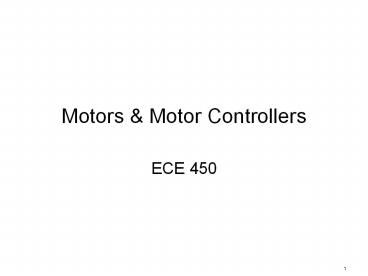Motors & Motor Controllers - PowerPoint PPT Presentation
1 / 26
Title:
Motors & Motor Controllers
Description:
Motors & Motor Controllers ECE 450 AC or DC Motors AC Few robots use AC except in factories Most of those that use AC first convert to DC DC Dominates in robotics ... – PowerPoint PPT presentation
Number of Views:492
Avg rating:3.0/5.0
Title: Motors & Motor Controllers
1
Motors Motor Controllers
- ECE 450
2
AC or DC Motors
- AC
- Few robots use AC except in factories
- Most of those that use AC first convert to DC
- DC
- Dominates in robotics
- Must be bidirectional
3
DC Motor Types
- Continuous-duty (run continuously when power
supplied) - Brushed
- Brushless
- Servo
- Intermittent-duty(power must be pulsed to run
continuously) - Stepper Motors
4
Motor Specifications
- Operating voltage
- Current draw
- Speed
- Torque
- Stalling or Running Torque
5
DC Motor Brush Motors
The most common. Toys, battery powered tools,
electric machines.
Stator (permanent magnets)
Brushes
6
Brush DC Motors
- Identify
- Stator
- Rotor
- Brushes
- Commentator
- Permanent Magnets
- Armature
- Field
Electrical Engineering Terms Armature The
power-producing component of an alternator,
generator, dynamo or motor. The armature can be
on either the rotor or the stator. Field The
magnetic field component of an alternator,
generator, dynamo or motor. The field can be on
either the rotor or the stator and can be either
an electromagnet or a permanent magnet.
http//mot-sps.com/motor/tutorial/blac.html
7
Brush DC MotorHow does it work?
8
Pulse Width Modulation (PWM)
Centered PWM
9
Brushless DC Motor
- Identify
- Permanent Magnets
- Rotor
- Brushes
- Commentator
- Armature
- Field
http//mot-sps.com/motor/tutorial/blac.html
10
Brushless DC Motor
- Laminated steel stack
- Winding
- Shaft
- Permanent Magnets
Less common. Higher efficiency, less friction,
less electrical noise. Requires electronic
driver.
11
Brushless DC MotorHow does it work?
12
DC Servo Motor
A DC Servo Motor is a DC Motor with Gears and
Electronics with limited angular rotation
(typically 90, 180 or 360º)
- Why the addition of gears?
- Nylon
- Karbonite
- Metal
- Why electronics?
- Digital
- Analog
http//www.societyofrobots.com/actuators_servos.sh
tml
13
DC Servo Motor
Requires constant pulsing (? 50 times / second)
http//www.seattlerobotics.org/guide/servos.html
14
DC Servo MotorWiring to Microcontroller
- Servo motors have three wires power, ground, and
signal. - The ground wire is typically black or brown and
should be connected to a ground . - The power wire is typically red, and should be
connected to the voltage source. - The signal pin is typically yellow, orange or
white and should be connected to the
microcontroller
15
Stepper Motors
Very common. Required driver. Very strong, when
not rotating. Easy to control rotor position.
The stepper motor rotates in set angles for each
pulse received. Typicalangles are turns 30º,
15º and 7.5º.
An 8 lead stepper is wound like a unipolar
stepper, but the leads are not joined to common
internally to the motor.
http//www.stepperworld.com/Tutorials/pgUnipolarTu
torial.htm
16
Stepper Motor Controllers
- With the appropriate logic, step motors can be
bi-directional, synchronous, provide rapid
acceleration, stopping, and reversal, and will
interface easily with other digital mechanisms.
They are further characterized as having low
rotor moment of inertia, no drift, and a
noncumulative positioning error. - Generally step motors are operated without
feedback in an open-loop fashion and sometimes
match the performance of more expensive DC Servo
Systems. The only inaccuracy associated with a
step motor is a noncumulative positioning error
measured in of step angle.
http//www.anaheimautomation.com/intro.htm http//
arduino.cc/en/Reference/StepperUnipolarCircuit
17
Stepper Motor
Very common. Required driver. Very strong, when
not rotating. Easy to control rotor position.
Full Step
Half Step
http//mot-sps.com/motor/tutorial/blac.html
18
Full-Step Stepper Motor
19
Half-Step Stepper Motor
20
Using an Atmel Tiny2313 and SN754410 H-Bridge
http//www.instructables.com/id/Drive-a-Stepper-Mo
tor-with-an-AVR-Microprocessor/
21
Motor DriversSimple, 1- dc motor (brushes),
on/off driver
9 V
M1 DC Brush
D1 1N5817 (Schottky)
M
C
Q1 2222A (NPN)
B
On to 9 V Off to GND or disconnected
R1 1 k?
E
22
Transistors
PNP Bipolar Transistor
NPN Bipolar Transistor
http//www.kilowattclassroom.com/Archive/AN0007.pd
f
23
DC Brushed Motor DriversSimple, 1-motor, on/off
driver
9 V
R2 1 k?
E
On to GND or disconnected Off to 9 V
Q2 2907A (PNP)
B
C
M1 DC Brush
D1 1N5817 (Schottky)
M
24
Motor DriversClassic Bipolar H-Bridge
On to GND or disconnected Off to 9 V
On to GND or disconnected Off to 9 V
Terminal 2
Terminal 4
Terminal 1
Terminal 3
On to 9 V Off to GND or disconnected
On to 9 V Off to GND or disconnected
Taken from Intermediate Robot Building by David
Cook
25
Motor DriversClassic Bipolar H-Bridge
9 V
R2 1 k?
R4 1 k?
E
E
D2 1N5817 (Schottky)
D4 1N5817 (Schottky)
B
B
C
Q4 2907A (PNP)
C
Q2 2907A (PNP)
from microcontroller
M
GND
Q3 2222A (NPN)
Q1 2222A (NPN)
from microcontroller
M1 DC Brush
R1 1 k?
R3 1 k?
C
C
D1 1N5817 (Schottky)
D3 1N5817 (Schottky)
B
B
E
E
Taken from Intermediate Robot Building by David
Cook
26
Motor DriversTypical H-Bridge Motor Driver
Taken from Intermediate Robot Building by David
Cook































